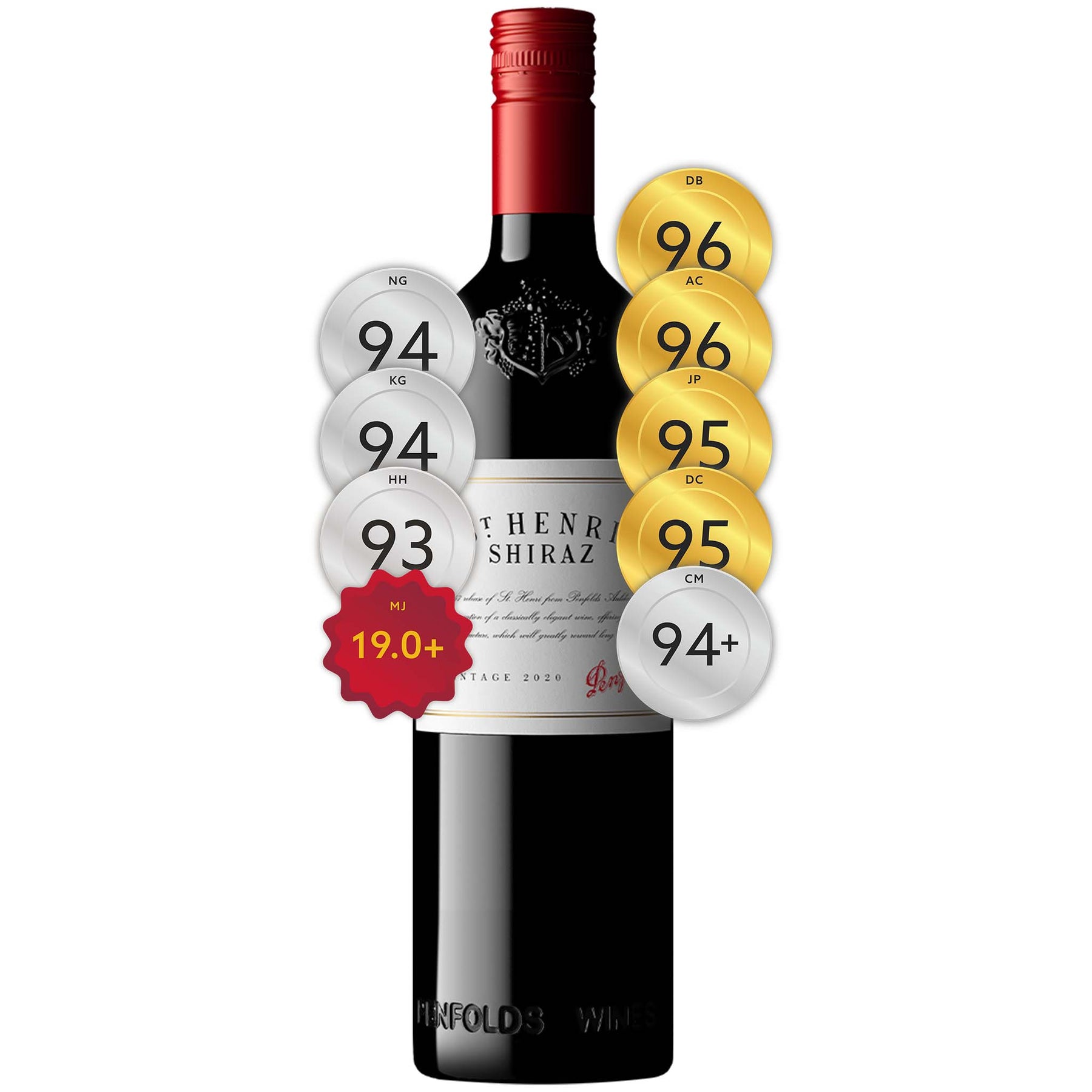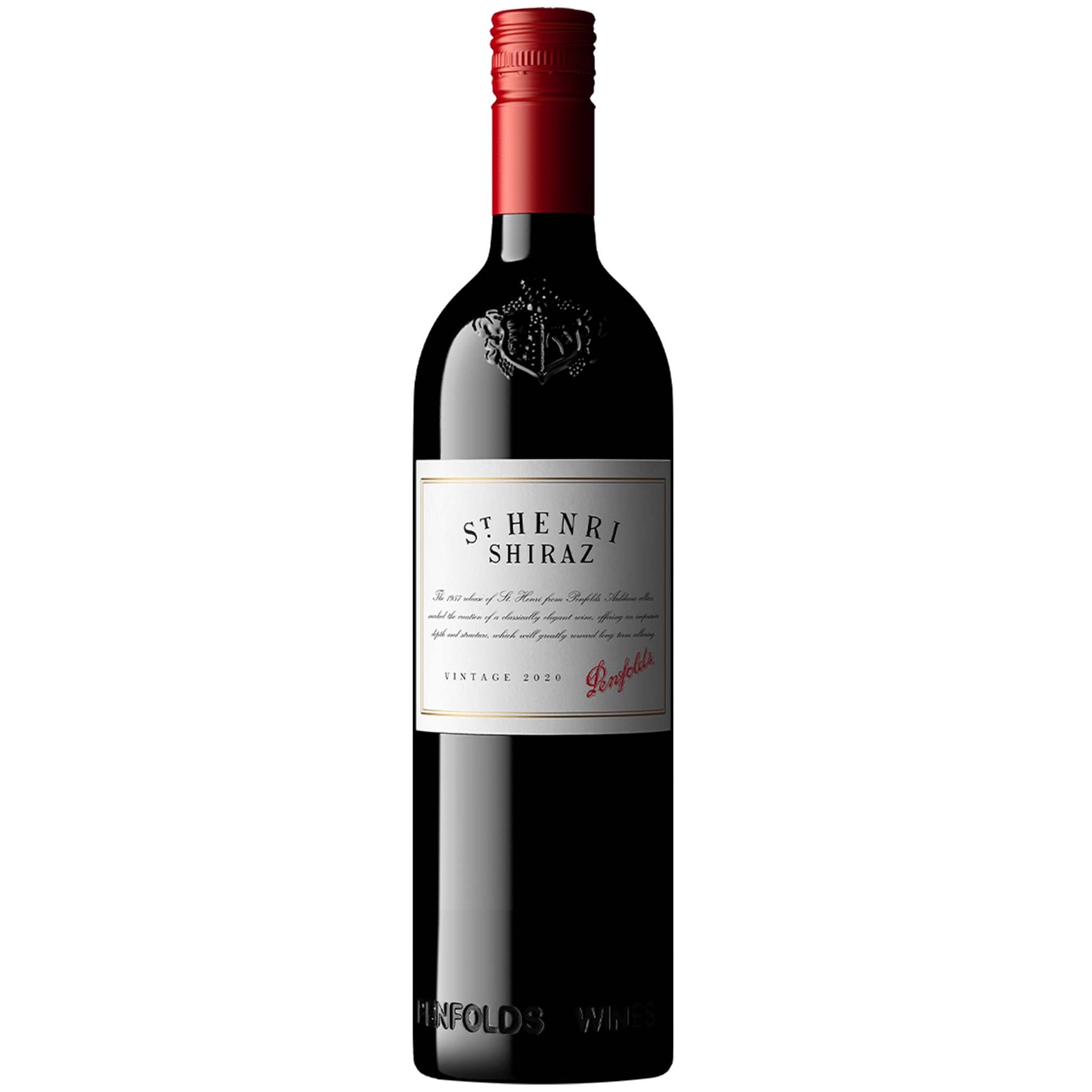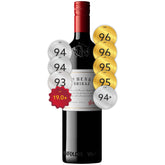

Penfolds St Henri Shiraz 2020
Style: Red Wine
Variety: Shiraz
Closure: Screwcap
Penfolds St Henri Shiraz 2020
Warehouse
34 Redland Drive
Vermont VIC 3133
Australia
Critic Score: 96 and 19/20
Alcohol: 14.5%
Size: 750 ml
Drink by: 2045
St Henri is a time-honoured and alternative expression of Shiraz, and an intriguing counterpoint to Grange. It is unusual among high quality Australian red wines as it does not rely on any new oak. Released for the first time by Penfolds in the early 1950s (first commercial vintage 1957), it gained a new lease of life in the 1990s as its quality and distinctive style became better understood. Proudly, a wine style that hasn't succumbed to the dictates of fashion or commerce. St Henri is rich and plush when young, gaining soft, earthy, mocha-like characters as it ages. It is matured in old, 1,460 litre vats that allow the wine to develop, imparting minimal, if any oak character. Although a small proportion of Cabernet is sometimes used to improve structure, the focal point for St Henri remains Shiraz.
"St Henri has always been one of my favourite Penfolds wines. It's such a comforting wine, with its unobstructed view of fruit and vintage, finishing savoury with powdery tannin grip and a dusting of cocoa powder and coal dust. Lovely stuff." Dave Brookes
"The abiding character of St Henri is its longevity, particularly in the context of better vintages. It has none of the make-up of new American oak that can hide the imperfections of a lesser vintage. A great St Henri will come into its own in a bare minimum of 10 years, and live long thereafter." James Halliday
The 2020 Penfolds St Henri is 100% shiraz from premium vineyards in McLaren Vale, Barossa Valley and Clare Valley. It was aged for 12 months in large seasoned oak vats.
"Garnet red with a dark purple core. The fruit profile is a delight, oak playing no role in the aromatics. Shiraz, unadulterated! The descriptors need to be coaxed from the glass with a gentle swirl. Fruits of the forest are first to emerge, berry conserve, strawberry flan and rhubarb tart. There is a hit of confectionary, reminiscent of red glace cherries. Savoury notes include German Blutwurst spiced sausage, pan scrapings from roast lamb and salt cured beef with black peppercorns. Ferric notes of iron filings and whetstone swarf round out an impressive showing. True to form, the palate is quite savoury. Japanese nori paper and olive brine offer a very morish umami nuance. Fresh blueberry and mulberry leaf anchor the core of the mid-palate. Exotic spices adding intrigue, Alleppey turmeric, toasted cumin, pimento. The tannins are very tactile, comparable to Dutch cocoa. A classic St Henri that will reward extended time in the cellar. Peak drinking: Now – 2050." Penfolds
Expert reviews
"This is an awesome and statuesque St Henri with commanding tannins and a glossy, succulent indulgent and luxurious feel throughout. It has incredible weight and stunning balance and ripeness. I worry that people will drink it the moment it arrives on their doorstep because the fruit is so darned luxurious, but I can imagine that it will run for decades such is the class on display here. Drink 2025 - 2050. 14.5%." Matthew Jukes - 19.0+/20 points
"St Henri has always been one of my favourite Penfolds wines. A multiregional shiraz aged for 12 months in large, old oak vats, I was always enamored with its less percussive attributes and proven lineage of cellar worthiness. Crimson with pure notes of plum compote, cherry clafoutis, roasting meats, earth, spice, ironstone, mocha, pan juices and the fainest wisp of wintergreen. It's such a comforting wine, with its unobstructed view of fruit and vintage, finishing savoury with powdery tannin grip and a dusting of cocoa powder and coal dust. Lovely stuff. Drink by 2045." Dave Brookes, Halliday Wine Companion - 96 points
"Deep crimson. Fragrant inky, blackberry, graphite aromas with hints of roasted walnut and spice. Complex and evolved with blackberry, dark chocolate, tobacco leaf, chinotto flavours, fine loose knit lacy chalky firm tannins, and underlying graphite, walnut notes. Finishes claret firm and tight. A refined style with lovely complexity and mineral length. Should develop very well. 100% Shiraz, McLaren Vale, Barossa Valley, Clare Valley, 12 months maturation in large seasoned oak vats. Drink 2025 – 2040 14.5%." Andrew Caillard MW, The Vintage Journal - 96 points
"Where the 2019 St. Henri was a quiet starter, the ’20 is straight out of the blocks, back to its usual and immediate warm, comforting embrace. The sourcing – McLaren Vale, Barossa Valley, Clare Valley – bears witness to generous, ripe fruit in blackberry, black cherry, earth, undergrowth, Aussie bush and a delightful spiciness. St. Henri is always a fruit-driven style enhanced in texture and mouthfeel by time spent in large seasoned oak vats (12 months in ’20) which brings with it, savoury cured meats, leather, a thread of dried herbs and plush choc-cocoa. The ’20 opens up easily, invitingly, with tannins drawing in nicely to close. Drink: 2023-2043" Jeni Port, Wine Pilot – 95 points
"Always the most unique, savoury and graceful red in the Penfolds stable, beloved for the fact it does not see any new oak (just 12 months in large, seasoned vats) and thereby emphasises the unadulterated purity of South Australian Shiraz. And the dry, low-yielding 2020 vintage has delivered an already approachable St Henri whose score may well improve with further maturation (in the meantime I wait with rapt anticipation for the 2021…). More McLaren Vale fruit joins the Barossa and Clare parcels this vintage thanks to late summer rain, and the result is a textured, mineral, fresh-fruited profile that conjures up rhubarb, cherries and wild strawberries along with seaweed, curry spices and polished leather enveloped in dusty, textured tannins." Tina Gellie, Decanter – 95 points
"This is a bit of a surprise packet. It’s quite bold for a St henri. It’s also inherently complex, even as a young wine. Meats, herbs, cherries and plums, with clove, fennel and smoke notes dancing throughout. It’s juicy. It plays treble and bass. It’s both typical and atypical. St Henri is often the hardest wine to access as a young wine of all the Penfolds’ wines; here we are again. It’s a juicy conundrum inside a meaty enigma. No one will mind the extra fruit power here. Drink: 2026 - 2036+." Campbell Mattinson, The Wine Front - 94+ points
"While this is a very fine wine, it is not, for me, a great St Henri. 100% Shiraz from McLaren Vale, Barossa and Clare Valley, it spent twelve months in large seasoned oak vats. The colour is a dark deep red. There are notes of florals, rose petals, raspberries, dry herbs, warm earth and violets. Finely balanced with decent length, a pleasing flick of acidity runs the length. We have hints of smoked delicatessen meats on the palate with satiny tannins that provide some serious grip. Drink for ten to fifteen years. A very good, not great St Henri." Ken Gargett, Wine Pilot - 94 points
"Dense, dank and brooding. A very warm vintage, serving an incantation of licorice strap, clove, camphor, dried nori and a spicy backdrop to a flood of dark, saturated fruits. Often the cuvee that I prefer most, however the tannins in this instance are more four-square, burlier, thick grape skin-gritty and less resolved than usual. A bit drying. The oak, classy and firm, compressing and directing. Best after 2028." Ned Goodwin MW, JamesSuckling.com - 94 points
"Deep bright red-purple colour, youthful and fresh, the bouquet of meaty/charcuterie, dry-spices and freshly tilled earth. In the mouth it's very savoury, very drying, loaded with fine silty tannins, an elegant St Henri but this time with quite assertive tannins that dominate the finish. Give it time. Drink: 2025–2040." Huon Hooke, The Real Review - 93 points
About st henri

The first vintage of St Henri – then Auldana Cellars St Henri Claret – was produced in 1888, beginning one of the most famous and enduring names in Australian wine. It was likely named after Auldana's winemaker Léon Edmond Mazure's son Henri or his wife, Philomine Henriette. The wine immediately enjoyed success, winning the Championship Cup for Best Claret in Australia at the Adelaide Wine Show in 1890 and then again as a joint winner in 1891. The St Henri label disappeared somewhere around the beginning of World War 1, probably because of reduced export sales. It was revived by Senior Red Winemaker John Davoren at Penfolds in 1953 to celebrate the centenary of Auldana Cellars (established by Patrick Auld in 1853) but the wine was not widely released. The 1953 release was made from Auldana and Paracombe fruit and the label design was based on original St Henri labels found in a loft at Auldana Cellars shortly after its sale to Penfolds in 1947.
According to retired Penfolds Senior Winemaker John Bird, the first vintages of St Henri were cabernet sauvignon and mataro blends. The fruit was foot stomped in open-ended hogsheads during vinification. After fermentation, the wine was matured in oak vats rather than hogsheads for around 18 months. John Davoren's aim was to make a wine in the traditional Claret style, accentuating fruit and maturation characters, rather than oak complexity. In this way the winemaking style differs to Grange, as it relies on larger seasoned oak vessels without any barrel fermentation. The 1957 vintage is officially recognised as the first St Henri commercial release under the Penfolds name. Nonetheless, John Davoren describes all of the 1950s vintages as “trials”. These experimental wines from 1953 to 1959 mark an important step forward for winemaking in Australia. Not only does St Henri honour the late 19th-century aspirations of Auldana's proprietor Sir Josiah Symon and winemaker Léon Edmond Mazure, but witho
s of Australia 2022 - James Sucklingut the professional rivalry between Max Schubert and John Davoren, the Grange story would not have the same richness or romance. Initially St Henri achieved greater commercial success than Grange, although both were offered to the public as Claret styles. St Henri was a more elegant, approachable and familiar style because it reflected traditional winemaking techniques, whereas the revolutionary Grange was something of a blockbuster with more richness and fullness.
Today Penfolds St Henri is a multi-regional multi-vineyard South Australian blend, primarily based on shiraz, although it still honours the original style. Significant contrbutions of shiraz come from Barossa Valley, Eden Valley, Clare Valley, McLaren Vale, Langhorne Creek, Robe and Bordertown; cabernet sauvignon from Coonawarra, Barossa Valley and Adelaide Hills. After vinification the wine is matured in seasoned large oak vats for around 15 to 18 months before bottling.
St Henri was labelled 'Claret' until the 1989 vintage. Packaged in laser-etched bottles
since the 1996 vintage. Released in many markets under screwcap since 2005. St Henri Shiraz possesses a unique stature in the story of Australian wine. With its proven style and aging potential, it is a favourite among Penfold's collectors.
Extract from Penfolds Rewards of Patience tasting panel 2021
After the success of early sherries and fortified wines, founders Dr Christopher and Mary Penfold planted the vine cuttings they had carried on their voyage over to Australia. In 1844 the fledging vineyard was officially established as the Penfolds wine company at Magill Estate.
As the company grew, so too did Dr Penfold's medical reputation, leaving much of the running of the winery to Mary Penfold. Early forays into Clarets and Rieslings proved increasingly popular, and on Christopher's death in 1870, Mary assumed total responsibility for the winery. Mary's reign at the helm of Penfolds saw years of determination and endeavour.
By the time Mary Penfold retired in 1884 (ceding management to her daughter, Georgina) Penfolds was producing 1/3 of all South Australia's wine. She'd set an agenda that continues today, experimenting with new methods in wine production. By Mary's death in 1896, the Penfolds legacy was well on its way to fruition. By 1907, Penfolds had become South Australia's largest winery.
In 1948, history was made again as Max Schubert became the company's first Chief Winemaker. A loyal company man and true innovator, Schubert would propel Penfolds onto the global stage with his experimentation of long-lasting wines - the creation of Penfolds Grange in the 1950s.
In 1959 (while Schubert was perfecting his Grange experiment in secret), the tradition of ‘bin wines' began. The first, a Shiraz wine with the grapes of the company's own Barossa Valley vineyards was simply named after the storage area of the cellars where it is aged. And so Kalimna Bin 28 becomes the first official Penfolds Bin number wine.
In 1960, the Penfolds board instructed Max Schubert to officially re-start production on Grange. His determination and the quality of the aged wine had won them over.
Soon, the medals began flowing and Grange quickly became one of the most revered wines around the world. In 1988 Schubert was named Decanter Magazine's Man of the Year, and on the 50th anniversary of its birth, Penfolds Grange was given a heritage listing in South Australia.
Despite great success, Penfolds never rests on its laurels. In 2012 Penfolds released its most innovative project to date - 12 handcrafted ampoules of the rare 2004 Kalimna Block Cabernet Sauvignon.
Two years later, Penfolds celebrated the 170th anniversary – having just picked up a perfect score of 100 for the 2008 Grange in two of the world's most influential wine magazines. Today, Penfolds continues to hold dear the philosophies and legends – ‘1844 to evermore!'.

South Australia
South Australian is responsible for more than half the production of all Australian wine. It is home to more than 900 wineries across 18 wine regions. The regions are Adelaide Hills, Adelaide Plains, Barossa Valley, Clare Valley, Coonawarra, Currency Creek, Eden Valley, Kangaroo Island, Langhorne Creek, McLaren Vale, Mount Benson, Mount Gambier, Padthaway, Riverland, Robe, Southern Fleurieu, Southern Flinders Ranges and Wrattonbully.
Many of the well-known names in the South Australian wine industry established their first vineyards in the late 1830s and early 1840s. The first vines in McLaren Vale were planted at Reynella in 1839 and Penfold's established Magill Estate on the outskirts of Adelaide in 1844.
South Australia has a vast diversity in geography and climate which allows the State to be able to produce a range of grape varieties - from cool climate Riesling in the Clare and Eden Vallies to the big, full bodied Shiraz wines of the Barossa Valley and McLaren Vale. Two of Australia's best-known wines, Penfolds Grange and Henschke Hill of Grace, are produced here. There is much to discover in South Australia for the wine lover.



